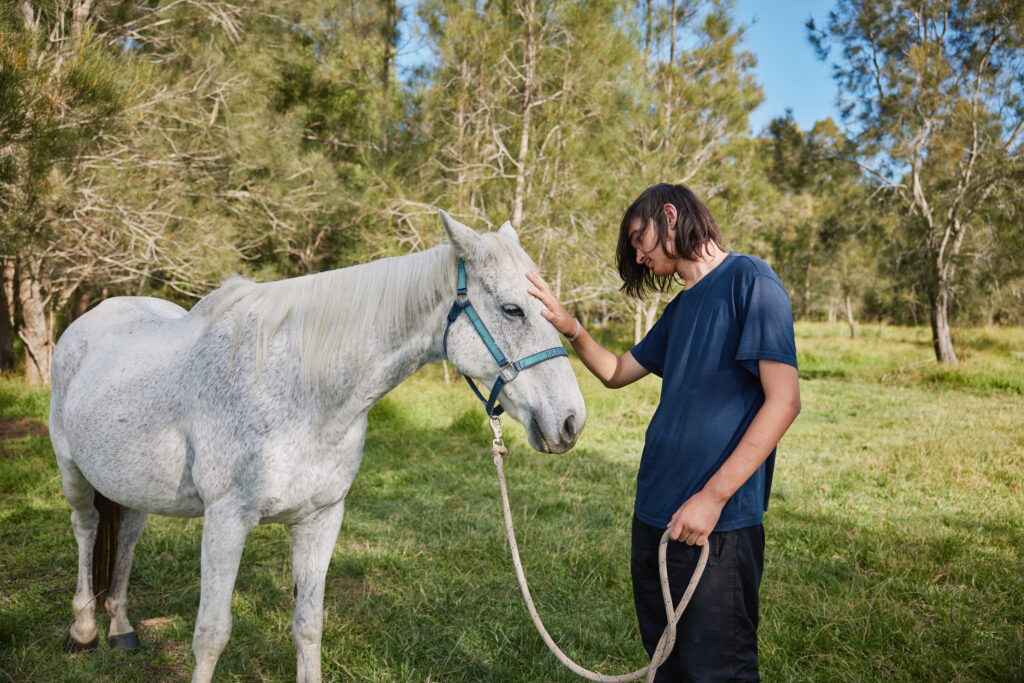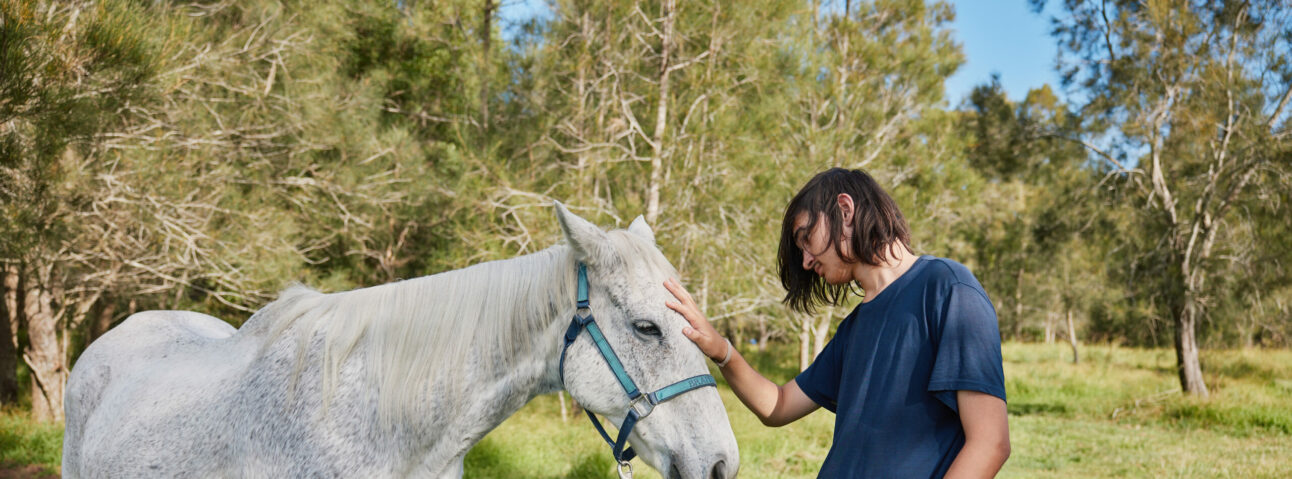Boundaries
Ever wondered whether you have good boundaries? Why creating boundaries is so important for your mental wellbeing? Or how to have better boundaries? Our Adventure Therapist Kane Abbott has all these answers and more for you below.
What are boundaries and why are they important for maintaining healthy relationships and personal wellbeing?
To understand what a boundary is it can be helpful to think about the physical boundaries of a football field or the fence line in a backyard. Boundaries are limits that help us define where something begins and ends. Personal boundaries are similar in that they help us understand where you begin and another person starts. Some people may be allowed to enter your yard or play on your field but there are some guidelines around how they can play.

Personal boundaries are defined by our values, needs, wants, and limits. They help support mutual respect between people and create comfort and safety. Boundaries cross time and space, they can be physical, emotional, spiritual, or cultural or they can be all at the same time. For example, a physical boundary might be; do not touch me. Or an emotional boundary might be; do not lie to me. In a sense, they are a set of guidelines that define how you would like people to treat you. It is important to remember that people have different boundaries. What might be okay with one person is not okay with the next person.
Boundaries however are not about changing the other person, they are about communicating to other people how you would like to be treated. What’s acceptable and what is not acceptable. Understanding your boundaries and learning healthy ways to communicate these with loved ones, friendships, co-workers and intimate partners is an essential skill for healthy relationships. When we can communicate and hold our boundaries, we can avoid feelings of not being seen, heard, or respected. We can avoid feelings of resentment, stress, or overwhelm. Boundaries help us to avoid feeling like we are blending with other people and ensure that we have a clear understanding of who we are. Therefore, in beginning this type of work, it is important to create or define your boundaries.
Why is saying ‘no’ an important skill to have? Especially when it comes to managing time, energy, and resources.
For some people, it can be very difficult to say ‘no’. People might feel that they will not be accepted, liked, or valued if they don’t agree to everyone’s requests. Constantly saying ‘yes’ can sometimes be a survival behaviour learned in past or current relationships, a means to keep everyone happy, keep yourself safe, or a way to feel needed. People may fear saying no and what might happen. In beginning boundary work it is important to understand what saying ‘yes’ all the time might mean for you. Explore it further, begin to unpack this tendency, and explore its origins. It can be difficult to just jump straight to learning to say ‘no’ without exploring and understanding where this aspect of self has developed from. Often this needs attunement and acknowledgement first before the skill of learning to say ‘no’ can be explored.

Learning to say ‘no’ is important because let’s face it we can’t always say ‘yes’. We are human and we have limitations, even if we want to do something for someone, we often simply can’t due to time constraints and other reasons. If we say ‘yes’ all the time it often comes at a cost to other aspects of our lives. This will inevitably lead to uncomfortable feelings because we have sacrificed something else that we value, to say ‘yes’ to someone else’s needs. Or we simply don’t have the time or resources to complete such a task. If we repeat this type of behaviour again and again, we build tension, resentment, and stress in our lives and those emotions will inevitably spill out somewhere else and perhaps not in the way we would want them. Saying ‘no’ can be an act of self-love and care but also it supports our overall well-being which in turn can support those we love and care for most. Saying ‘no’ when you don’t have the time, energy, or resource to complete a request is about learning to implement and maintain your boundaries. If saying ‘no’ is new territory for you, then you may need to develop your communication skills and practice healthy ways to express yourself whilst upholding your boundaries. This can often feel scary or uncomfortable at first but with time and practice you will feel more comfortable.
What are the signs of unhealthy boundaries?
As discussed earlier, healthy boundaries are defined by our values, needs, wants, and limits. However, unhealthy boundaries disregard these aspects and can place us into situations that might create relational or emotional complications or at worst unsafe relationships that could lead to abuse, manipulation, or control. We have to create and know our boundaries explicitly first before we implement and maintain them. When we have a clear sense of our boundaries we can intrinsically feel when they are being crossed or not upheld. However, there are some universal signs of unhealthy boundaries including; having difficulty expressing your perspective, denying or concealing your needs, or doing things at the cost of your own physical and emotional health. These are all examples of having boundaries that are too flexible but the opposite can be true too. Some people develop very rigid boundaries. They may struggle to open up or let other people in, have difficulty with serious conversations, or share their vulnerabilities with other people. These boundaries can cause a great deal of suffering for individuals and although their behaviour is motivated by a need for protection their avoidance of vulnerability hinders their ability to form meaningful relationships.

It’s important to remember that boundaries are not punishment. Healthy boundaries don’t seek to get you to change. The weaponization of boundaries to punish, manipulate or control other people is not okay. Withholding communication or giving people the ‘silent treatment’ is not a healthy way to communicate your boundaries or your needs. Remember the intention of the boundary is not to punish, control, appease, or push someone away, it is there to inform the other person how to treat you and to ensure that you have a happy, safe, and meaningful relationship.
What are some of the practical strategies for setting and creating boundaries?
As discussed, we need to know what our boundaries are first before we can implement them. This is a process of getting in touch with yourself and understanding who you are and why you are the way you are. You might have healthy boundaries in one area and not so healthy in other areas. Remember boundaries can span across multiple intersections of our lives including; work, family, friends, and intimate relationships. They can be spiritual, emotional, physical, or cultural.
Often if we have unhealthy boundaries, it’s because we carry an old message that we have internalized from an experience or because we have learned patterns of unhealthy boundaries from those around us. However, the good news is that we can change and we can recreate new patterns and healthy boundaries.
So, to begin this work you need to define your boundaries first. Start with a pen and paper and define your values, limits, wants, and needs. This important information will help to inform your boundaries. If you think you have some unhealthy boundaries, write them down too and then start to challenge and explore them. You might need professional support to unpack and understand where they come from and they might be connected to some painful wounds that need healing. Take the time to acknowledge and start the process of healing those wounds and piece by piece redefining your boundaries in healthy ways. Recreating healthy boundaries can be a healing process. But once you have perspective and level ground, start by defining them.
Okay, so now you know what your boundaries are, you then need to learn to implement and communicate those boundaries. This process can be challenging too because often there might be new ways of communicating that you haven’t used before. The ingrained thoughts that had supported your previous unhealthy boundary will often arise. For example, ‘I can’t believe you are going to say no to this person’ or ‘Your partner will leave you if you don’t do this’. All the fears will likely arise but it is important to stay connected to your intuition and what messages you feel in your body.

It might feel uncomfortable but you will know when you are on the right track. Practical tips around learning to communicate can be helpful too such as Using ‘I’ statements. This can be a simple way to start to express your boundaries. For example, “I feel angry when you lie to me, I would like for you to tell me the truth” or ‘ I’m sorry I don’t have time for that today. I want to help you but could we pick this up at a later stage’. What you might notice here is that the boundary is giving the person a choice. They can choose to continue their behaviour and be met with a boundary, for example, the removal of your support or presence or they can respect your boundary, and the relationship can change and evolve in new ways. It can also be helpful when communicating to avoid the use of “you” language to avoid triggering defensiveness in other people.
Remember to start small too, pick a place you would like to set a boundary in your life, perhaps something that doesn’t feel too overwhelming, and build up from there as you gain confidence and familiarity with setting boundaries. Once you start to define and implement your boundaries it’s important to continually review and maintain them. Maintenance of boundaries is just as essential as defining and implementing them. It’s easy to fall back into old patterns of responding, sometimes without even realizing it. We have to be honest with ourselves through the process and continually check in to know our truths. For example, regularly scan your internal world. Do you feel sick every time that person calls or texts? Then there may be a boundary being crossed there.
Boundary work is a journey and our boundaries are forever slightly changing and or adjusting as we develop, grow, and change throughout the stages of our lives. It isn’t a fixed location that we arrive at, it’s a fluid process that unfolds continuously throughout our lives. We have to learn to listen to the wisdom of our bodies and our intuition so that we can stay in harmony with ourselves, which in turn supports a deeper harmony with those around us.
If you would like to read more about creating boundaries, I would recommend you check out ‘How to do the work‘ by Dr Nicole LePera and or ‘Boundaries for the soul‘ by Dr Alison Cook.



